De Anza Cove Amendment to the Mission Bay Park Master Plan

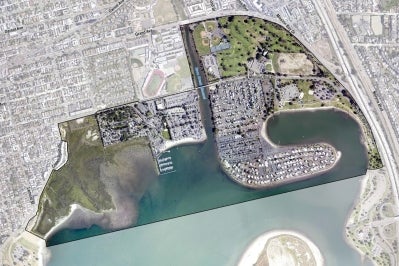 Project Goals
Project Goals
- Expand wetlands for habitat, public enjoyment, climate resilience and water quality benefits.
- Create an iconic recreation destination that maximizes the benefit offered to the region by this extraordinary waterfront amenity.
- Provide for the highest and best use of the project area to serve the needs of a broad range of local and regional users.
- Identify a mix of uses that will provide sustainable revenue generating leaseholds for the City.
To meet these goals the City has engaged the community and technical and design experts to determine the potential reuse of the project area to revitalize De Anza and surrounding areas and include a diverse mix of public recreation, camping, wetlands and other active regional park uses.
Project Status
On May 14, 2024, following years of engagement with stakeholders representing conservation, active recreation, boating and camping, as well as community members across the city, the City Council unanimously approved the De Anza Natural Amendment to the Mission Bay Park Master Plan. Reflecting the input of many stakeholders over the development of the amendment, De Anza Natural plans for:
- Over 140 acres of new wetlands that will provide new habitat, improve water quality, and further the City’s climate action and resilience goals;
- New low-cost visitor accommodations, providing access to affordable overnight coastal accommodations, camping, boating, and nature across 48.5 acres;
- Improved community serving recreational opportunities that maintains active recreation acreage that serves over 200,000 users per year and offers community-based recreational facilities for a growing population.
The City Council also certified the associated EIR, adopted the Findings, Statement of Overriding Considerations, and certified the MMRP for the Amendment to the General Plan and Mission Bay Park Master Plan.
City Council Adopted Documents
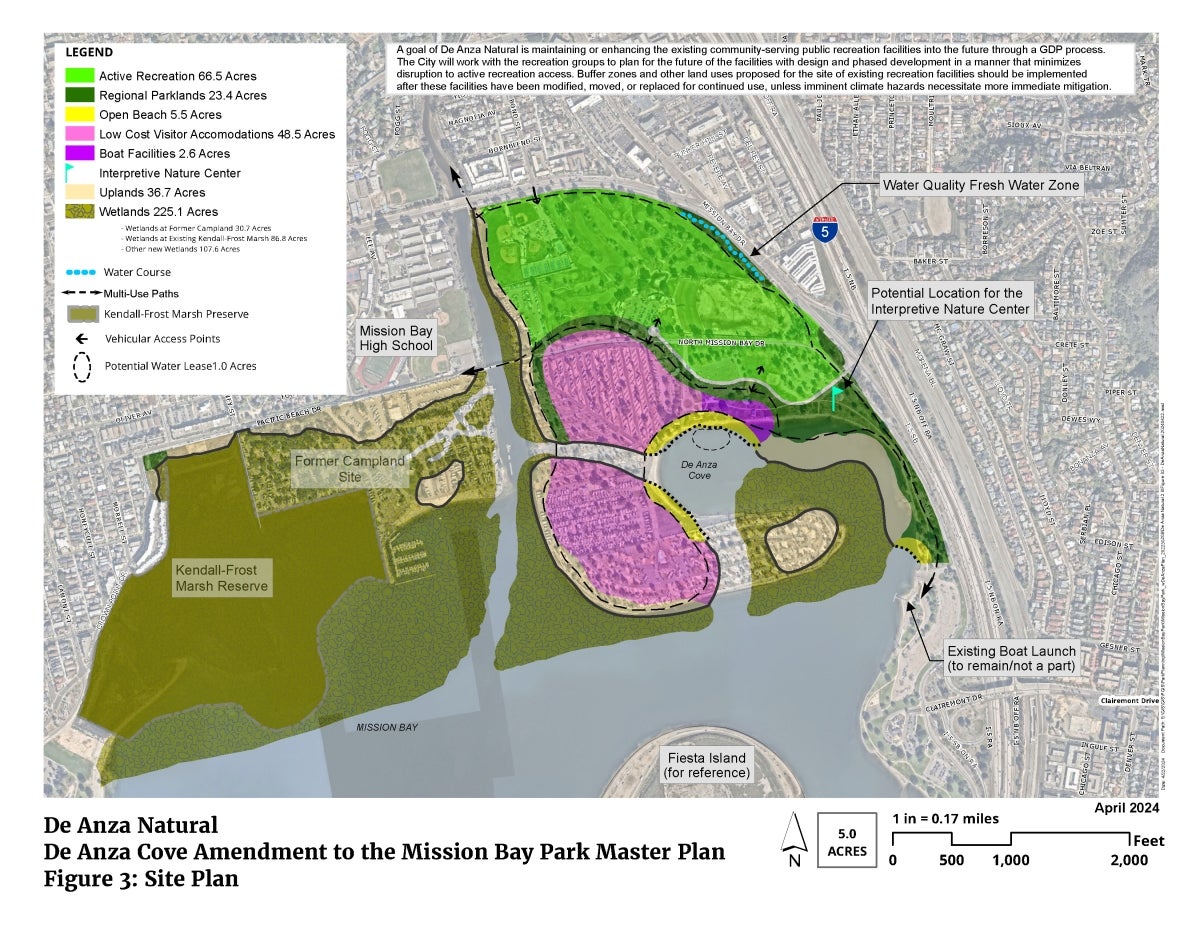
What's Next?
As part of the City’s Local Coastal Program, De Anza Natural must be submitted to the California Coastal Commission for review and certification. If the Coastal Commission conditionally certifies De Anza Natural with modifications, those modifications must be heard and adopted by the City Council before returning to the Coastal Commission for final and unconditional certification. Once De Anza Natural is final, implementation of the plan will begin with the General Development Plan (or GDP) process, which is initiated by the Parks & Recreation Department. Through this public process, preliminary conceptual designs will lead to a preferred plan and accompanying cost estimates and schedules. Based on the approved GDP plans, construction documents will be prepared and permitted for construction. For more information on these steps and estimated timelines, please see the De Anza Natural Fact Sheet linked below.
De Anza Natural Fact Sheet – August 2024
How does the Plan relate to the Mission Bay Park Master Plan?
The project site falls within the boundaries of the adopted Mission Bay Park Master Plan – a regional park that serves all of the residents of San Diego as well as visitors. The Revitalization Plan is subject to Park goals and objectives in the Mission Bay Park Master Plan. The final plan shall be the basis of the amendment to the Park Master Plan.
The Mission Bay Park Master Plan currently provides for the following land use recommendations for the DeAnza Project Area:
- Regional recreation needs, including guest housing (camping facilities and recreational vehicles) and beach access.
- Wetlands to contribute to the park’s water quality.
- Hydrologic improvements to safeguard the viability of marsh areas.
- Trail, viewing areas and other recreational features to enhance public use of the study area.
- Leaseholds that support the Mission Bay recreation use.
View park-wide recreational uses in Mission Bay Park.
How does the Plan relate to the ReWild Mission Bay?
The De Anza project is an effort lead by the City of San Diego to revitalize the project area to provide for the highest and best use of the area to serve the local and regional needs of the public. The ReWild project is being conducted by a coalition organized by the San Diego Audubon Society to restore wetlands along Pacific Beach Drive and both sides of Rose Creek. Please visit the ReWild project site at rewildmissionbay.org for more information.
Project History
The process to amend the De Anza component of the Mission Bay Park Master Plan officially began in 2018; however, public meetings and discussion of the topic stretch back as far as late 2015. Here you can find an archive of the many meetings, documents and outreach efforts associated with this effort.
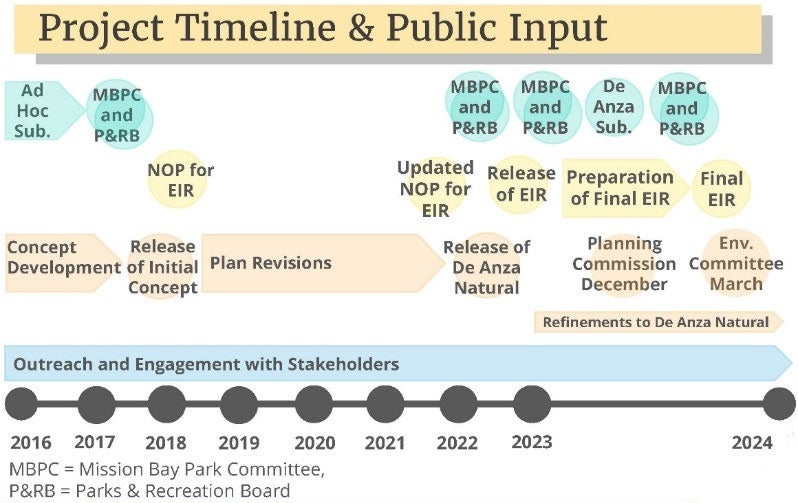
Past Engagement
April 2024
The City Planning Department posted the De Anza Natural amendment draft documents for public review, and the link to final PEIR was shared. To review a copy of the April 2024 amendment highlighting the changes made since the February 2024 amendment, view the April track-changes amendment.
April 2024 Draft Exhibits
March 2024
The City Planning Department presented De Anza Natural and the final PEIR to the Environment Committee on March 14th. The Environment Committee, after hearing from stakeholders of different viewpoints, voted to move the amendment on to the full City Council for consideration. The meeting agenda, the presentation, and written comments can be found on the Committee’s agenda page. Scroll down to the Project History section to view previous site plans and amendment documents.
Documents Considered at Environment Committee, March 2024
• De Anza Natural and Alternative Site Plans
• De Anza Natural Mission Bay Park Master Plan Amendment
Winter 2023-2024
The Planning Commission reviewed the De Anza Natural Amendment and associated PEIR on December 7, 2023. Following testimony from the various stakeholders that have been engaged throughout the process, the Commission voted 6-0-1 to recommend adoption as presented.
The public is invited to comment on the De Anza Natural Amendment to the Mission Bay Park Master Plan, which will shape the future improvements and uses at De Anza Cove. Comments can be submitted using the below comment box and are welcome continuously throughout the hearing process. To review a copy of the February 2024 amendment highlighting the changes made in response to the public input received thus far, view the February 2024 track-changes amendment.
The draft Program Environmental Impact Report (PEIR) for the proposed De Anza Natural Plan Amendment to the Mission Bay Park Master Plan was released for public comment in March 2023, and the 45-day public review and comment period ended on April 20. The final PEIR is available on the CEQA webpage.
November 2023
Over the summer, City staff engaged with stakeholders, including an ad hoc subcommittee formed by the Parks and Recreation Board with representatives from the Mission Bay Park Committee and the Parks and Recreation Board. At the five Committee meetings, stakeholders provided detailed and valuable presentations on desired recreational uses, visitor accommodations and habitat restoration.
In July, both the Mission Bay Park Committee and the Parks and Recreation Board gave their recommendations; the Mission Bay Park Committee voted to support and recommend the adoption of De Anza Natural and the draft PEIR, while the Parks and Recreation Board voted not to approve. View the meeting minutes from the Mission Bay Park Committee and the De Anza Ad Hoc Committee and the Parks and Rec Board.
Staff completed the final PEIR, which includes a detailed sea level rise analysis and responses to public comments on the draft PEIR that were received during the public review period. The final PEIR has been posted.
November 2023 Draft Exhibits
Spring 2023
De Anza Natural, a proposed draft amendment to the Mission Bay Park Master Plan, was released for public comment in March of 2023. Developed with input from the public and stakeholders representing the wide variety of interests and uses at De Anza Cove, De Anza Natural envisions a balance of land uses that serves local and regional recreational needs, while also restoring natural habitats and preparing for the impacts of climate change. Since the release, several refinements have been made to the initially released land use map in response to community and stakeholder comments. These refinements were reflected in the maps and amendments dated June 2023.
May 2023
March 2023
In March 2023, the City released De Anza Natural, a proposed draft amendment to the Mission Bay Park Master Plan, along with the Draft PEIR for public comment. Informational items were presented to the Mission Bay Park Committee and the Park & Recreation Board, where staff heard from a variety of stakeholders.
- De Anza Natural Amendment to the Mission Bay Park Master Plan (March 2023 Draft)
- De Anza Natural and Alternate Site Plans (March 2023 Draft)
September 2022
In September 2022, the City released three plan alternatives in addition to the no-project alternative required by CEQA to be studied alongside the De Anza Natural plan in a programmatic environmental impact report. These alternatives were developed by City staff, who considered the many comments received from the public following the release of the Notice of Preparation in early 2022 and stakeholder comments received from the Mission Bay Park Committee and the Parks and Recreation Board.
March 2022
In March 2022, staff presented the De Anza Natural plan as an informational item, along with the EIR process for the De Anza Cove Amendment to the Mission Bay Park Master Plan. The committee and the public gave comments to staff on a wide range of concerns. View meeting minutes.
On March 17, 2022, staff presented the De Anza Natural plan as an informational item and gave a synopsis of the EIR process for the De Anza Cove Amendment to the Mission Bay park Master Plan. The board and the public gave comments to staff on a wide range of topics, summarized in the meeting notes.
January 2022
Notice of Preparation
On Jan. 11, 2022, a new draft land use plan for De Anza Cove, along with a new Notice of Preparation, was made available for public review.
Scoping Meeting
The City of San Diego hosted a virtual Scoping Meeting on January 24, 2022 to discuss the environmental review process for the De Anza Cove Amendment to the Mission Bay Park Master Plan.
Planning Efforts
2021-Early 2022
The City Planning Department is evaluating nature-based alternatives that would result in an expanded wetland in De Anza Cove. Enhanced wetlands have the potential to increase climate resiliency, carbon sequestration and provide for quality habitat for endangered plants and animals. Wetlands can provide recreational and educational opportunities that would be unique to northwest Mission Bay.
History in Brief
2019-2021
The 2018 City concept plan was reevaluated as stakeholder input continued to be received. The City received supplemental funding from the Northeast Mission Bay Wetland Restoration Supplemental Environmental Project (SEP) to study additional wetlands creation.
Summer 2018
PEIR NOP public scoping meeting on the 2018 project was held on June 20, 2018.
Public Meeting Pre-2018 Calendar
Mission Bay Park Committee Meeting – December 5, 2017
Thank you to all the public members who attended the Mission Bay Park Committee meeting on Dec. 5, 2017. The two DeAnza Revitalization concept plan alternatives were presented to the Committee as an action item. The action was to recommend a preferred alternative for the basis of the amendment to the Mission Bay Park Master Plan and for the Environmental Document. The Committee’s recommendation was to move forward with the revised alternative 2 as presented to the Committee, as the basis of the EIR analysis.
Mission Bay Park Committee - Action Item
The Mission Bay Park Committee meeting will be held at the Mission Bay High School auditorium on Dec. 5, 2017, at 6 p.m. The two refined draft concept alternatives for the DeAnza Revitalization will be presented to the Mission Bay Park Committee for a recommendation of a preferred concept plan.
Parks and Recreation Board Informational Item - November 16, 2017
Presentation of two Refined Draft Concept Alternatives to the Parks and Recreation Board.
Ad-Hoc Committee Meeting #6 – June 29, 2017
There was robust attendance from the community that provided great feedback and asked many insightful questions.
The meeting began with a presentation by the Project Team that included an overview of the meeting purpose and goals and a review of the Mission Bay Master Plan Goals and Guiding Principles. In response to all the input received from Community Workshop #3 and online engagement activities in November, where the public provided feedback on the three preliminary Draft Concept Alternatives, the Project Team provided a highlight summary of the highest supported uses and alternatives.
After setting the stage, the Project Team provided a detailed presentation of the two Refined Draft Concept Alternatives. The Ad-Hoc Committee then had a focused discussion in response to the Refined Draft Concept Alternatives, providing comments, asking questions, and sharing their perspective.
Following the Ad-Hoc Committee meeting members of the public were invited to participate in an Open House and review the two Refined Draft Concept Alternatives in more detail. Members of the Project Team were available to meet and talk with members of the public and ask questions about the Alternatives.
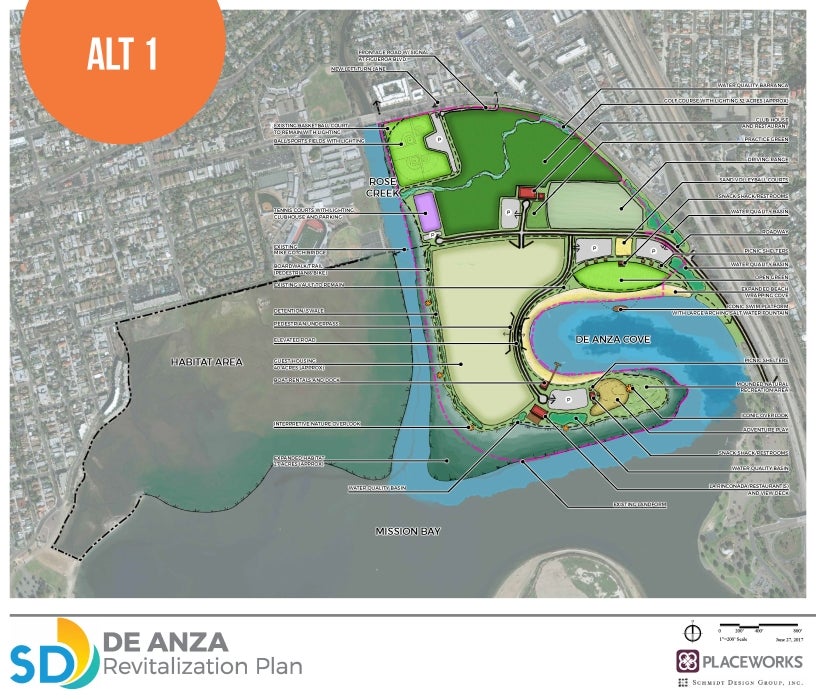
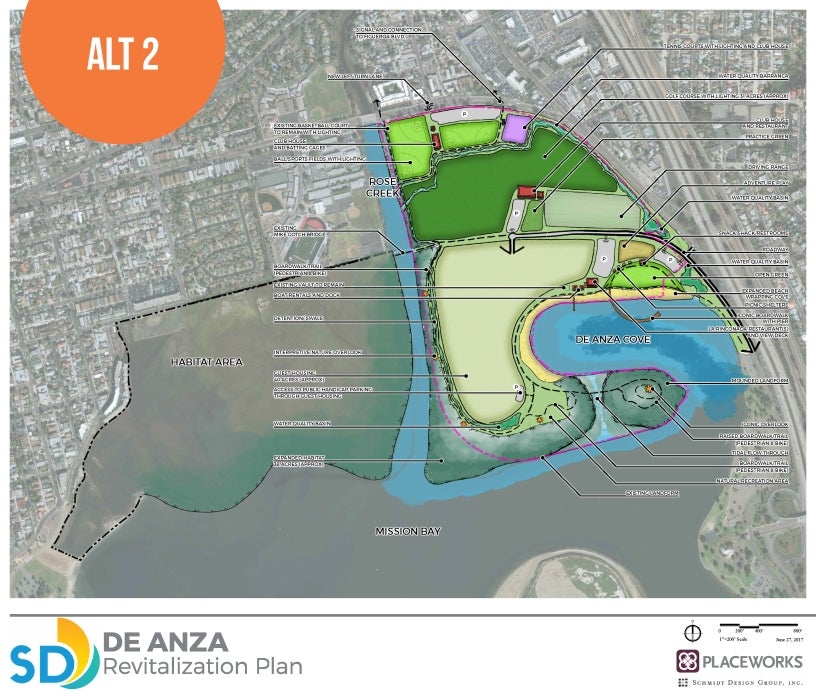
Public Workshop #3 – November 7, 2016
Community Workshop #3 meeting on Nov. 7, 2016, began with a presentation by the Project Team that included an overview of the community outreach process conducted to date and a detailed presentation of the three draft Concept Alternatives. The workshop then transitioned to an open house which provided attendees with the opportunity to see the draft concept alternatives up close, ask questions of the Project Team, and provide feedback on draft uses, design, and potential refinements.

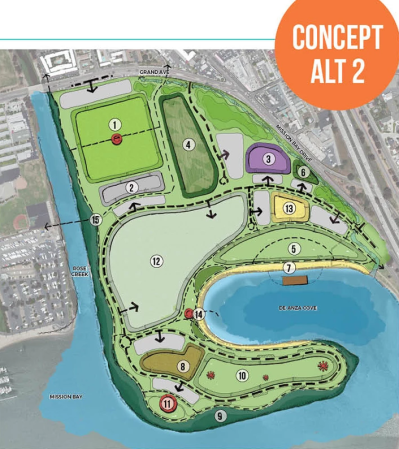
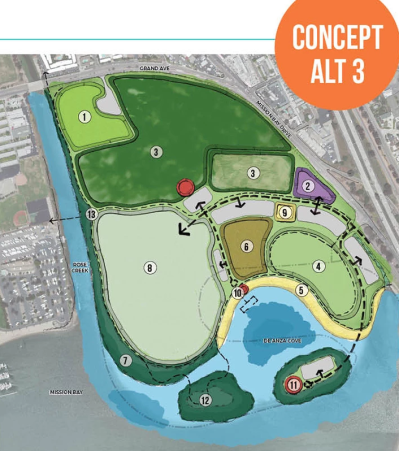
Ad-Hoc Committee Meeting #5 – June 16, 2016
The fifth Ad-Hoc Committee meeting on June 16, 2016, included an overview of activities conducted at the Community Workshop #2 and online activities, participation in a similar group design activity with the Ad-Hoc Committee that mirrored what was done at Workshop #2, and participation in an additional program prioritization dot exercise with the public
Online Program Prioritization Activity June – July 2016
Throughout the De Anza Revitalization Plan outreach process, the community and the Ad-Hoc Committee have provided significant feedback on amenities and programs they would like to see and focus on for the future of the De Anza project area, including participation online in the Program Prioritization Activity that mirrored the activity that took place at Workshop No. 2.
Public Workshop #2 – April 27, 2016
Community Workshop #2 on April 27, 2016, provided an opportunity to hear from the design team about the opportunities and constraints analysis findings and case studies of visionary parks and park features from around the world. Over 200 attendees came together and collaborated in groups to prioritize future programs and uses and then designed their own concept plans for De Anza.
Ad-Hoc Committee Meeting #4 – April 14, 2016
The fourth Ad Hoc Committee meeting on April 14, 2016, focused on discussion of the existing conditions and issues and constraints for natural resources and other environmental conditions, hearing about community/stakeholder-generated concepts, looking at iconic park case studies, and brainstorming and prioritizing potential uses. View Exiting Conditions Workbook.
Ad-Hoc Committee Meeting #3 – March 9, 2016
The third Ad Hoc Committee meeting on March 9, 2016, focused on seeking the Ad Hoc Committee’s refinement of a draft vision and guiding principles, providing existing conditions information on the transportation network, a leasehold analysis of existing leases and projected future demand, and an overview of existing uses within the project site and in the adjacent areas.
Ad-Hoc Committee Meeting #2 – February 10, 2016
The second Ad Hoc Committee meeting on Feb. 10, 2016, focused on seeking the Ad Hoc Committee’s refinement of a draft vision and guiding principles, providing an update on public involvement events, an overview of the Mission Bay Park Master Plan and California Coastal Act, and a discussion of the scope of the existing conditions analysis and input on issues and constraints.
Public Workshop #1 – January 28, 2016
Workshop No. 1 on Jan. 28, 2016, kicked off the De Anza Revitalization Plan project with the public. The workshop was conducted in an “open house” format with opportunities for public input at “topic stations.” Each topic station included short presentations and displayed relevant maps and information on focused topics, including natural resources, transportation, existing uses, economics, vision/future uses and amenities, project overview, and public information to gather initial input on key issues and priorities.
Ad Hoc Committee Meeting #1 / Open House – December 9, 2015
The first Ad-Hoc Committee meeting on Dec. 9, 2015, focused on introducing committee members and the community to the project. Content included a project overview (background, boundary, and key components), an overview of the public involvement plan, and a preliminary brainstorming of the project vision and guiding principles.

